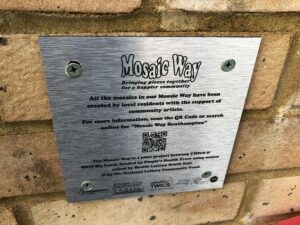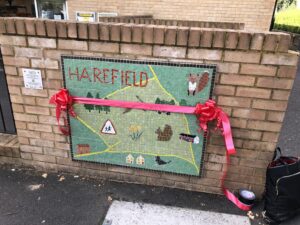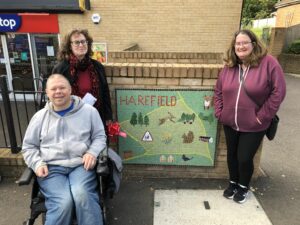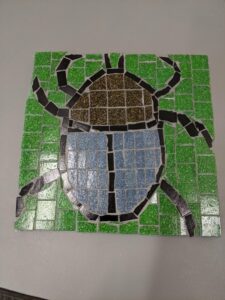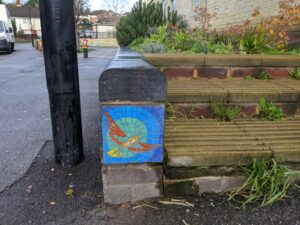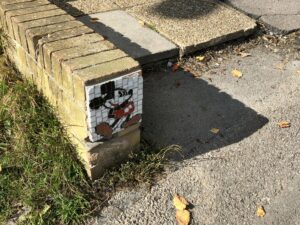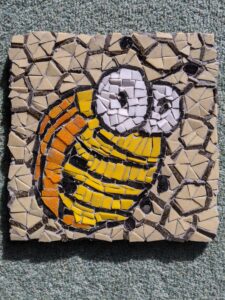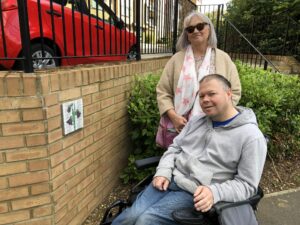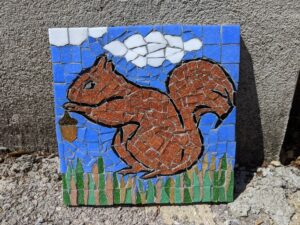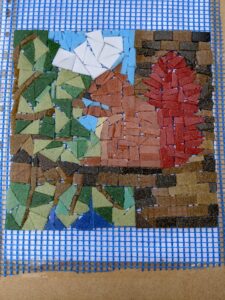A new Mosaic Way: Connecting the dots in SO18
‘Bringing pieces together for a happier community’. Journalist-at-large, Harriet Marsden, meets residents of SO18 Big Local for the unveiling of ‘Mosaic Way’, a creative outdoor arts project aimed at bringing the community together.
Last month residents of SO18 Big Local celebrated the unveiling of a ‘legacy project’ and lockdown lifeline: a community trail of mosaics.
More than 30 people in Townhill Park and Harefield and Midanbury, just outside of Southampton, have spent the past two years learning to make small mosaic artworks, which their teacher and commercial artist Will Rosie then installs on neighbourhood streets. During the pandemic, the group collaborated on two large mosaic murals for their local hubs by each making a portion at home. Now, 60 mosaics connect the disparate estates, dotting low walls and street signs, and impressionistic maps of each area adorn the Townhill Community Centre and Harefield Hub.
The project has given residents a chance to express their thoughts on their area in a collaborative, artistic way.
At the ribbon-cutting ceremony, Big Local chair and Townhill Park resident Kim Ayling described the finished Mosaic Way as “a legacy project”. “When we first conceived the idea,” said Ayling, “we gave it the strapline of, ‘Bringing pieces together for a happier community’. And that is exactly what happened.”
The project has given residents a chance to express their thoughts on their area in a collaborative, artistic way. During lockdown, when locals were forced to take their mosaics home, they set up Whatsapp groups to chat and swap photographs, which they say became something of a lifeline. “They were giving each other support and encouragement, friendship and applauding each other’s work,” says Ayling.
Each mosaic reflects on the theme of nature, with butterflies, birds and a beloved local fox making an appearance. Locals and visitors can download a ‘spotter sheet’ with the location of each piece, as well as a picture, description, the artists’ names and the installation date. There’s even an interactive map and QR code. “The spotter sheets are evidence of what an achievement their – and our – Mosaic Way really is,” Ayling told local media and residents. “I’m proud of them, and for them. It’s a wonderful, wonderful project and I hope it gets us on the list for City of Culture.”
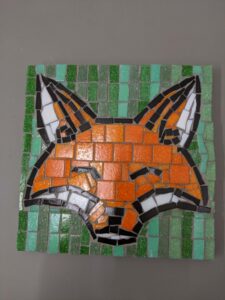
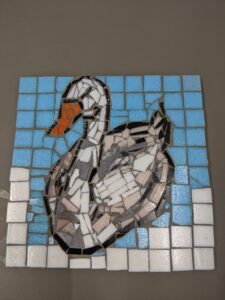
At the unveiling, Southampton City Councillor Dan Fitzhenry said: “It’s really great to see all the different ideas and designs come together, of what people think of their community, and then that badged together in a mosaic which exemplifies it in a physical form – not only the output, but all the work that goes into making it. To see a picture that has all these different ideas of what an area represents is really powerful.”
The project has created friendships and a bond in the community, as well as some really good aesthetic stuff.”
That, he says, is what S018 and the wider regeneration project in the area is all about: not just new buildings, but the community and the fabric underneath. Like many post-war housing estates, the SO18 area is somewhat disconnected from the city centre but rich in local history, nature and pride. Ten years ago, Fitzhenry says, the area “needed something to lift it up … some more TLC” – hence the regeneration project. “The project has taken a long time but these sorts of examples, the Mosaic Way, of community activity, helped people along the way.”
Rosie adds: “The project has created friendships and a bond in the community, as well as some really good aesthetic stuff.”
The SO18 group had long been preoccupied with how to connect the separate communities within their Big Local area. “There was always a rumbling about how our area is divided into neighbourhoods that don’t mix, divided by a main road, so it’s not a natural area – it’s a bit of a mishmash,” says Ayling. “It was always such a headache trying to balance things, and we said, if only we had some way of getting people to feel comfortable walking in a different neighbourhood that’s right on their doorstep. How about a trail?”
I just stuck them wherever I fancied putting them up around the city.”
Meanwhile, Rosie, who has lived in Southampton since he was ten, decided that the city “needed some permanent art”. “Someone should do something about that, and then I thought, well maybe that someone’s actually me.”
Will began by creating small facsimiles of the Mr Men characters in mosaic tile – “and I just stuck them wherever I fancied putting them up around the city.” Then he branched out to Marvel characters, then the Simpsons. His mosaics just kept popping up all over town. Illegally, I ask? He laughs: “I prefer the term ‘permission vague’.”
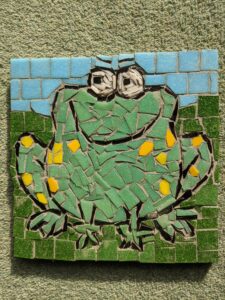
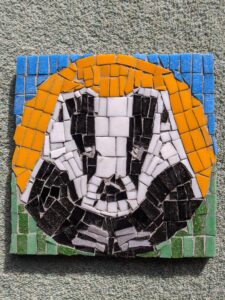
By the time anyone realised it was him putting up the pieces, “the whole city had fallen in love with the mosaics”.
The majority of the council are “really good people and they’re cool for that kind of thing,” but there were some who raised an objection to him hammering through the proper bureaucratic process. “They were like, without a by your leave he’s gone off and done this and I’m like, yeah, so what? People love it, and that’s it.” (Rosie is currently in the process of writing a book about his work called, ‘Mr Mosaic: Unarrestable.’)
As he waves goodbye to Mr Unarrestable, Councillor Fitzhenry just laughs. “I’m one of those unconventional characters as well,” he says. “At the end of the day, we all want to get the job done, and sometimes the system can be a bit problematic. Maybe Will’s used a route that’s sometimes unconventional but the end result is that we’ve got some really good stuff, and people love it. That’s what matters.”
In his own words, Rosie had become “a bit of a big deal in regards to art, so everybody knows my name and everyone’s aware of my work”. Noticing his guerrilla jigsaws, Ayling and Barbara Hancock (the SO18 community development lead) commissioned Rosie to help families paint wooden bollards in Townhill Park. After a session, Rosie, Hancock and Ayling were standing outside “having a chinwag” about the idea of some sort of trail. The People’s Health Trust had just opened grant applications to Southampton – and, as Ayling puts, “it was a lightning bulb moment for the three of us”.
I knew it was such a brilliant idea. The criteria for the grant was about people meeting together over at least a year and making new friendships, so you could easily imagine how it was going to work.”
They realised, almost simultaneously, that a mosaic project was an apt metaphor for bringing separate jagged pieces together to create something beautiful, and would also work as an interactive community trail. “I always explain it like, you know that word, kismet? Some people say the definition is preparedness meeting the opportunity, and that’s exactly what happened that day,” says Ayling. “It was kismet. It was meant to be.”
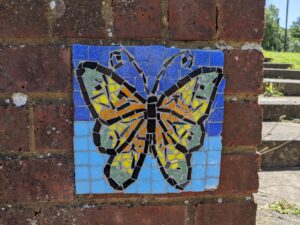
Hancock agrees. “I knew it was such a brilliant idea. The criteria for the grant was about people meeting together over at least a year and making new friendships, so you could easily imagine how it was going to work.”
I truly do believe that it was meant to be.”
Rosie, along with community artist Gillian Jeffery, set up workshops at the Townhill Community Centre and the Harefield Hub, teaching the art of mosaicing to locals. When lockdown suddenly hit, Jeffery turned the group’s unfinished individual mosaics into home kits, with protective glasses and clippers, and sent them home. Then, says Ayling, they set up the WhatsApp group. “That became hugely important for people – not just for mosaics, but to be involved in this common endeavour, and it became something people could do during lockdown.” Getting agreement about the collaborative designs was tricky, she says, because each piece was made by an individual, “but put together, they were fabulous.”
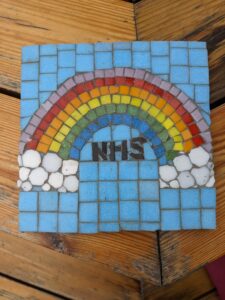
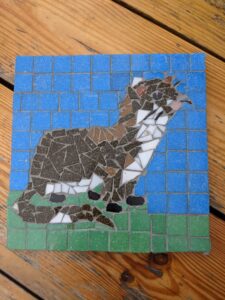
Hancock agrees that without lockdown, some things would have been easier, like the collaborative murals, but then they’d never have had the mutual support of the WhatsApp groups.
Hancock says that in all her years in community development, she’d never known of a project where there was such general knowledge of it, but the mosaics are extremely eye-catching. “It exceeded our expectations. I think it’s astonishing that all those pieces fit together.”
As Ayling says, “I truly do believe that it was meant to be.”
With the help of Hamlett Films, Big Local residents have been telling their stories. Jo Proctor’s Mosaic Way film tells the story of how and why the project came to be and how the art trail connects the three local neighbourhoods.
Harriet is Local Trust’s journalist at large. She is travelling the country meeting communities in Big Local areas and writing about their stories.
If your Big Local has a story to share, a project you’re keen for Harriet to come and see, or if you just want to say hi and have a chat, get in touch via email or Twitter.

